|
|
Post by kemp on Feb 2, 2018 17:44:45 GMT -5
Close up of the complex hilt design.  |
|
|
|
Post by zaskar24 on Feb 2, 2018 18:29:55 GMT -5
That is Nathan's I believe. Not my era of interest but a great sword none the less and one that I would not mind ending up with from A&A. Craig and the crew are great to work with.
|
|
|
|
Post by kemp on Feb 4, 2018 0:21:12 GMT -5
Myself, I favour the High Middle Ages and late medieval/renaissance when it comes to edged weaponry. I especially like Nathan Robinson’s German bastard sword repro based roughly on a 1500 original. Note the nicely done antique finish and leather work on the handle. 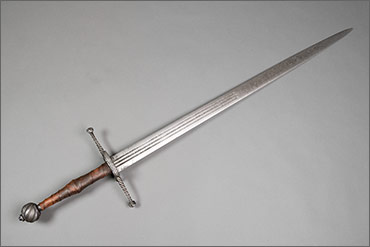 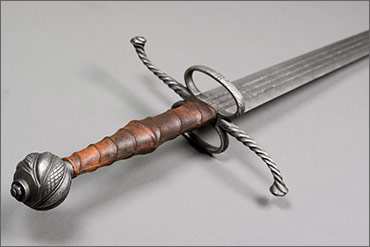 |
|
|
|
Post by kemp on Feb 4, 2018 0:35:27 GMT -5
On the subject of 'Mediaeval Swords from Southeastern Europe’ Here are some two handed XVIa ( cut and thrust ) swords from 14th century Serbia held at the museum of Jagodina in central Serbia.  Some two-handed swords, like these in the Jagodina Museum bear specific signs of joined heart and cross, and were probably forged in local Serbian workshops. On page 48 of the ‘Mediaeval Swords from Southeastern Europe’ there is a good description of this type of sword found in western Serbia in the site of Kovacnica, ten swords and daggers recovered. It was the site of blacksmith’ workshop, Kovacnica translates to Smithy. The site and village was part of an estate that included a monastery founded by the Serbian feudal lord Bogdan around 1418. The weapons hoard was buried just before the area became subject to the Turkish conquests. There were also other two handed swords found in Serbia and other southeast European locations which came by way of trade and were called wolf swords due to an engraved wolf on the blade, which was a trademark of swords originating from Passau, a German town in Bavaria. |
|
|
|
Post by kemp on Feb 4, 2018 0:41:40 GMT -5
Medieval Serbian weapons held at the museum of Cacak in western Serbia  Medieval 13th – 14th century sword found at the medieval remains at Rudnik in central Serbia, which was a mining and trading centre from the 12th to 15th century.  The sources of that time mention trading and sword making sites from the eastern Adriatic, Dubrovnik in particular, the Croatian hinterland, Bosnia and Serbia. |
|
|
|
Post by kemp on Feb 4, 2018 0:44:23 GMT -5
Bulgarian medieval swords from the Archaeological museum of Plovdiv, Bulgaria  |
|
|
|
Post by kemp on Feb 5, 2018 7:45:29 GMT -5
Here are some of the plates from the book ‘Medieval Swords from Southeastern Europe’ by Marko Aleksic. It is interesting to note that many of the swords held in the Military museum of Belgrade were located along the Sava and Danube river tributaries. 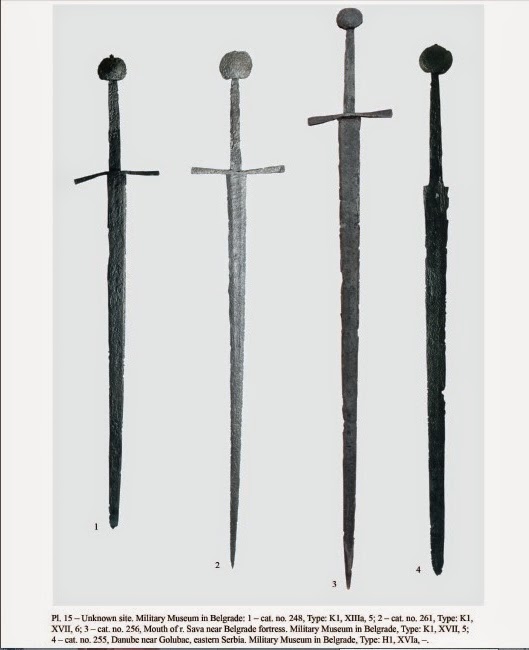  |
|
|
|
Post by kemp on Feb 5, 2018 7:46:29 GMT -5
Serbian medieval army equipment ( Military Museum Belgrade )  |
|
|
|
Post by kemp on Feb 5, 2018 7:51:52 GMT -5
Wallachian sword from the 15th century 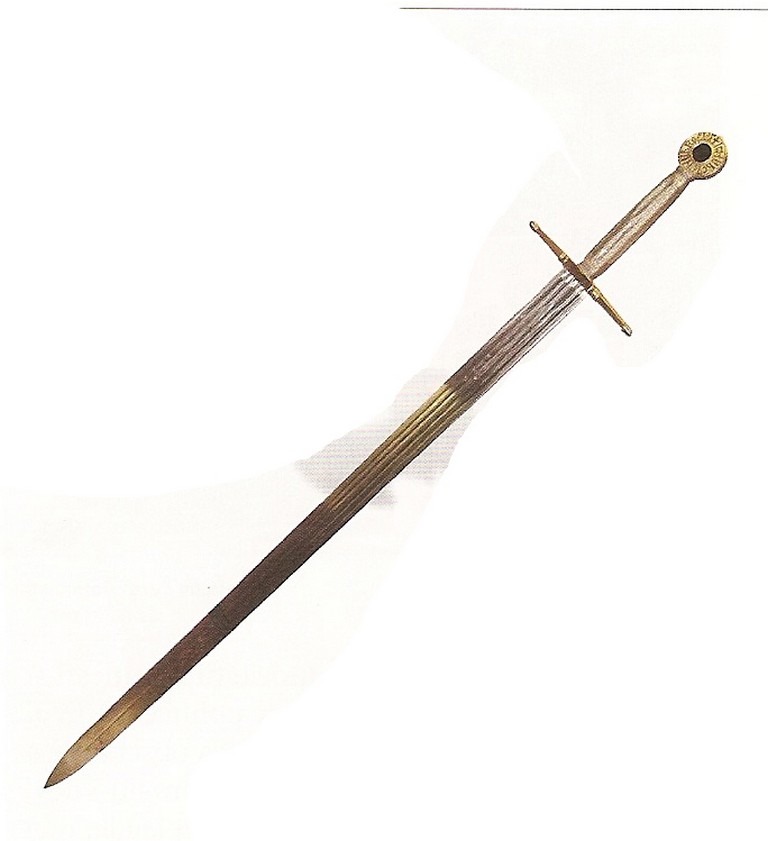 Note the multi fullers on the top half of this particular blade. Swords and coat of mail used by Wallachian soldiers exhibited in the National Military Museum in Bucharest Romania. 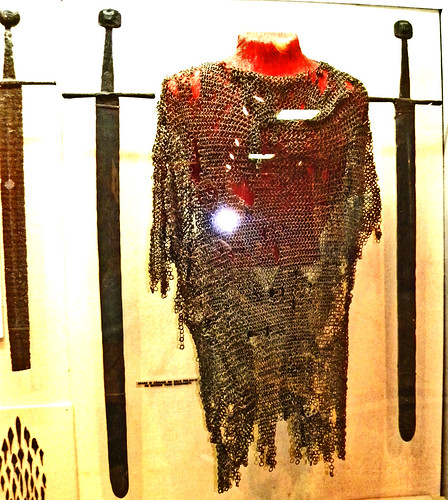 |
|
|
|
Post by Char-Vell on Feb 5, 2018 8:07:53 GMT -5
Thanks, Kemp!
Nothing makes my day like pictures of arms and armor!
|
|
|
|
Post by kemp on Feb 5, 2018 16:55:00 GMT -5
Thanks, Kemp! Nothing makes my day like pictures of arms and armor! Char-Vell, I concentrated most of the study on the medieval style of weaponry in southeast Europe, and in this case the hand and a half/two hand sword variant, but it is only a snap shot since it would be an exhaustive subject if I was to really get into the various weaponry used at the time. I figured I would look at that one aspect. If I included the latter influences of the Ottomans we could talk about sabers such as the Kilij, bows, maces, even the first use of artillery in the region, but I will leave that for others. Other curved swords from the east would include the Persian Shamshir, and going further east there is the Indian Tulwar and the Nepalese Kukri style blades ( reminiscent of the falcata and ancient kopis ). The eastern swords, notably near eastern scimitars,influenced the European sabers and cutlass, although curved European swords existed in various forms from antiquity. The scimitar seems to have been used extensively in the near east from the 11th century ( Central Asian influences ). Prior to that the Arabs and Persians had been using straight double edged blades for centuries. I like the Turkish Yataghan design.  I think I will need to resist the temptation to go into details on the interesting subject of the blades that existed between the European and far eastern world, and their influences on post medieval blade types in Europe. 600000011" style=tnabsolute; width: 9px; height: 6.3px; z-index: -9999; border-style: none; left: 0px; top: -1px;" id="MoatPxIOPT0_53340763"></iframe> <iframe width="9" height="6.300000000000011" style="position: absolute; width: 9px; height: 6.3px; z-index: -9999; border-style: none; left: 391px; top: -400px;" id="MoatPxIOPT0_2147955"></iframe> <iframe width="9" height="6.300000000000011" style="position: absolute; width: 9px; height: 6.3px; z-index: -9999; border-style: none; left: 0px; top: -140px;" id="MoatPxIOPT0_17113455"></iframe> <iframe width="9" height="6.300000000000011" style="position: absolute; width: 9px; height: 6.3px; z-index: -9999; border-style: none; left: 391px; top: -140px;" id="MoatPxIOPT0_72155653"></iframe> |
|
|
|
Post by kemp on Feb 7, 2018 7:30:02 GMT -5
There is a photo of Marko Aleksic holding what appears to be an original XVIa sword. .jpg) |
|
|
|
Post by kemp on Feb 7, 2018 7:31:48 GMT -5
|
|
|
|
Post by kemp on Feb 8, 2018 15:41:22 GMT -5
One particular interesting type that Aleksic describes is a variant of the two handed gripped sword XIII that was found in eastern Serbia, greatest use dated from the end of the 14th century and the beginning of the 15th century. Aleksic calls the type XIIIc. The characteristics of the XIIIc are a shorter length ( 73 – 83 cm ) than the larger XIIIa, broad bladed, but still of a long two handed hilt. Fuller runs one or two thirds of the blade length, point is short, rounded or triangular. Basically a more compact version of the larger XIIIa.  Note the XIIIc from eastern Serbia next to a longer XIIIa found near Belgrade.  |
|
|
|
Post by kemp on Feb 8, 2018 15:47:06 GMT -5
The different ratios between the length of the blade and hilt, when compared to the larger XIIIa, would assume different handling than for most other swords of the two hand gripped design with the longer blades generally found at the time. A special type to be used in both hands for swifter movements.
Aleksic notes that in some cases the XIIIc may represent regular sized two handers which had their blades broken in such a way as to adapt them into XIIIc types, but the fact that most have a similar pommels, type II, would indicate related origin and that they were forged that way.
XIIIc sword types are found in eastern Serbia, Hungary and Poland, some of these having longer and or narrower blades.
These ratios between handle length and blade are in no ways unique to the above regions, and I have read of finds in Denmark of XVIII swords with similar blade to handle length proportions, but what makes it stand out is that it represents a new sub category of the XIII type not previously identified in the Oakeshott typology.
|
|